Units, units, units
One final word before we head on to some more biological examples. You need to be sure that you are always using the same units when you do anything with ratios, proportions, percentages, or percent change. Remember, you are making comparisons, and if you don't use the same units, it's like comparing apples or oranges, or fish and birds, or whatever your favorite non-comparable items are.
 DON'T do this:
DON'T do this:
I used 1 pound butter
and 16 oz sugar
so, butter : sugar = 1:16 = 0.06 -> 6% wow that's low fat!!
It doesn't matter what units you use as long as you're consistent. (and some units will be more convenient than others, so do yourself a favor and use the convenient ones).
I hope you see above that fractions, ratios, proportions, and percents are all basically the same. They just tend to be used in different situations. Below is a sort of concept map, showing how to convert between them:

Ratio: any comparison of two numbers based on division, often used for part:part comparisons. Can also be written as a fraction.
Proportion: like a ratio, a comparison of two numbers by division, often used for part:whole
Percent: like a proportion, but expressed per hundred
The word “of” expresses multiplication in problems with fractions, proportions, or percentages.
Percent change: fundamentally different than the above, because you subtract first, then divide by the baseline, so it’s really change:baseline. Used to find how a quantity has changed over time or as a result of some sort of treatment.
Copyright University of Maryland, 2007
You may link to this site for educational purposes.
Please do not copy without permission
requests/questions/feedback email: mathbench@umd.edu